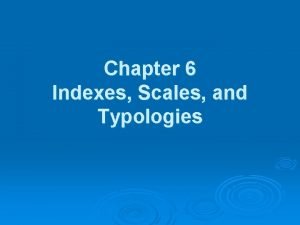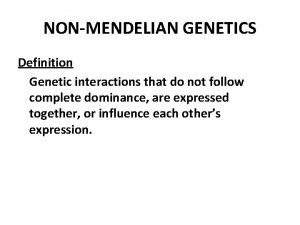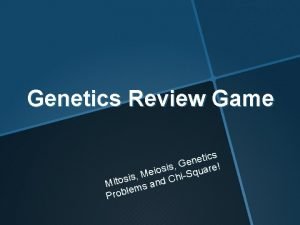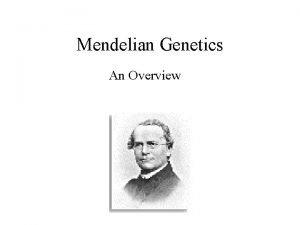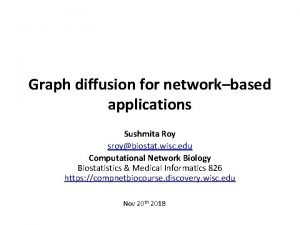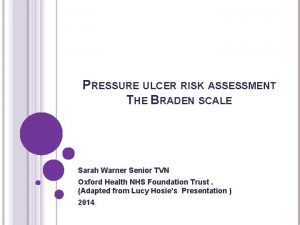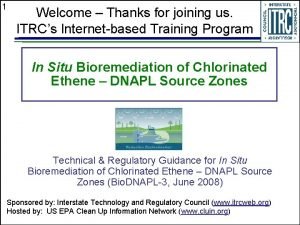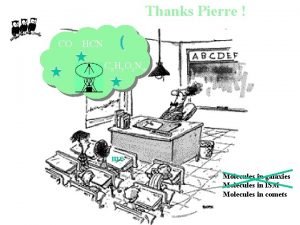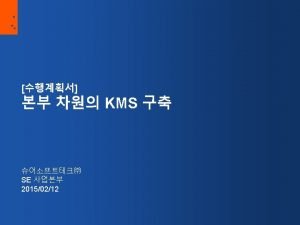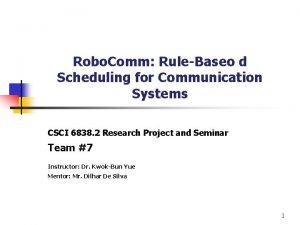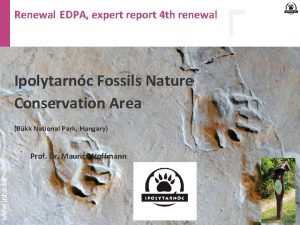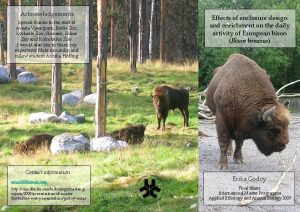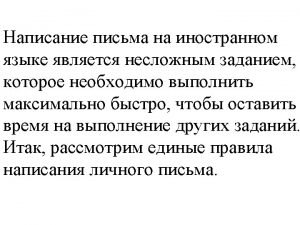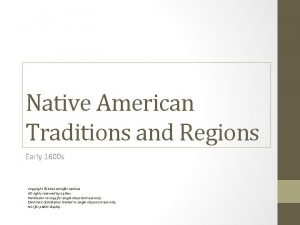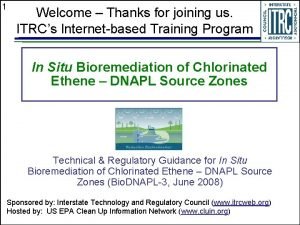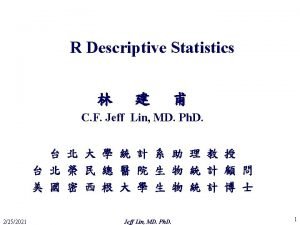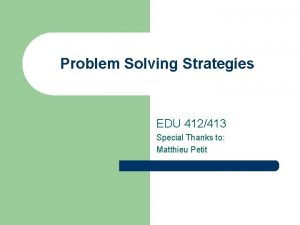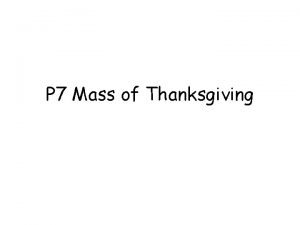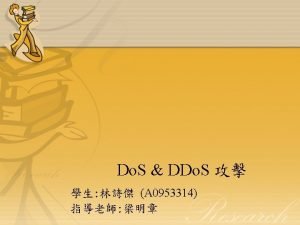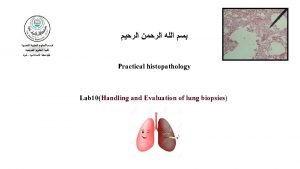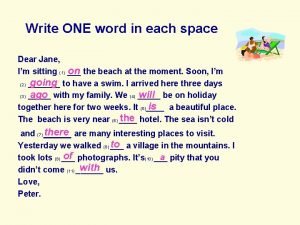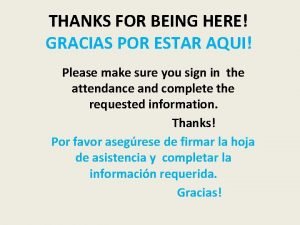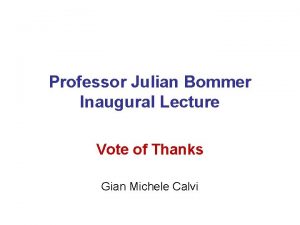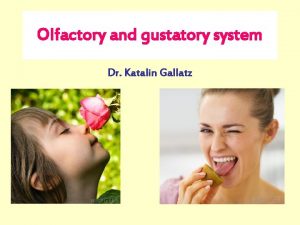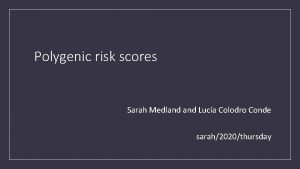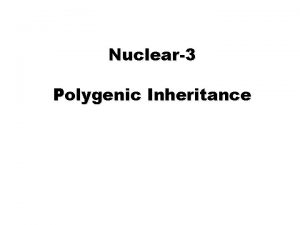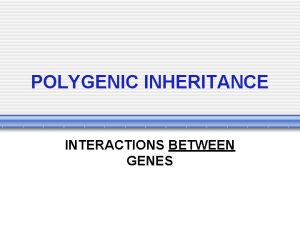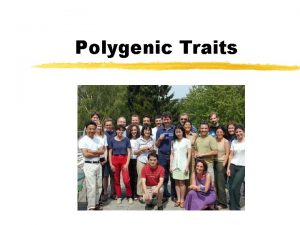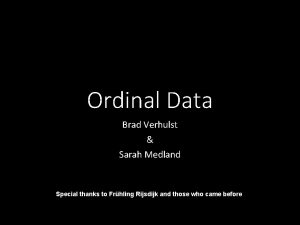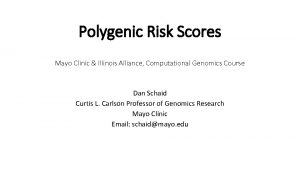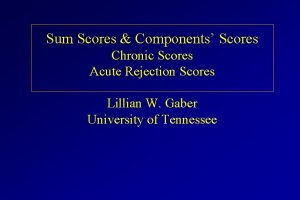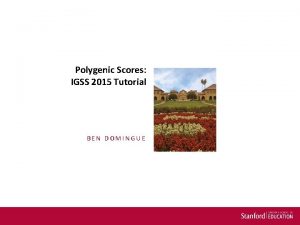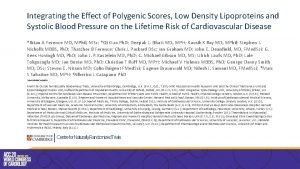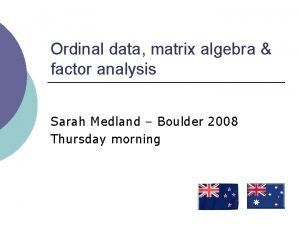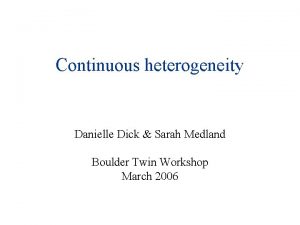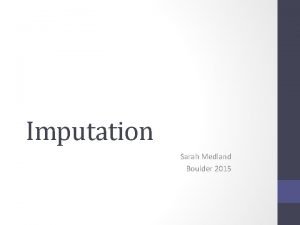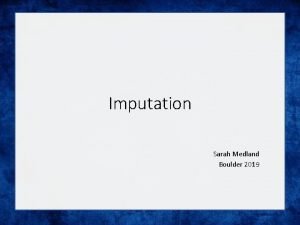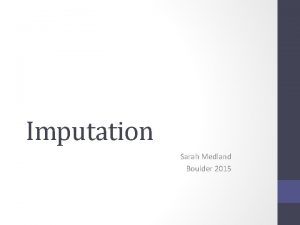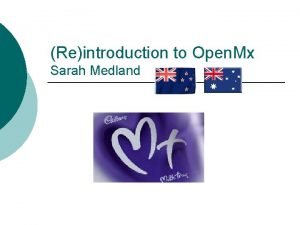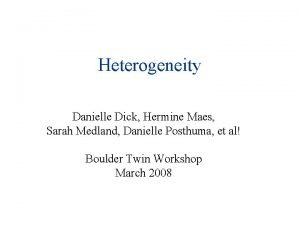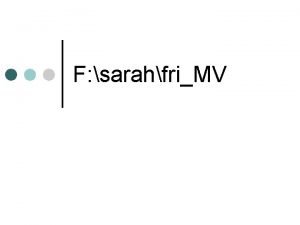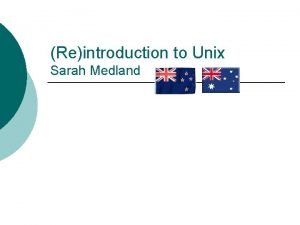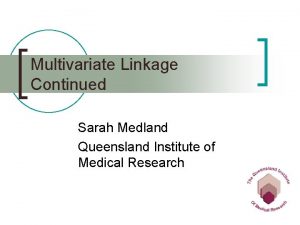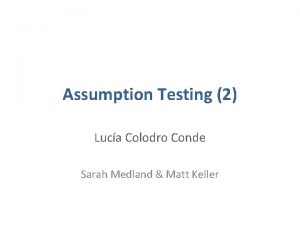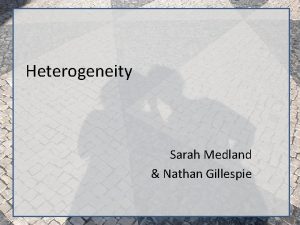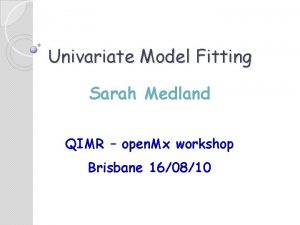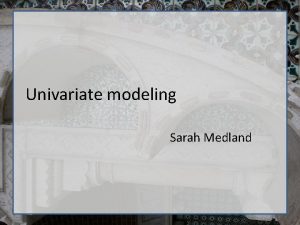Polygenic risk scores Sarah Medland with thanks to


































































- Slides: 66

Polygenic risk scores Sarah Medland with thanks to Lucia Colodro Conde & Baptiste Couvy Duchesne

What are Polygenic risk scores (PRS)? • PRS are a quantitative measure of the cumulative genetic risk or vulnerability that an individual possesses for a trait. • The traditional approach to calculating PRS is to construct a weighted sum of the betas (or other effect size measure) for a set of independent loci thresholded at different significance levels. • Typically the independence is LD based (LD r 2 <=. 2) via clumping.

The classics • Wray NR, Goddard, ME, Visscher PM. Prediction of individual genetic risk to disease from genome-wide association studies. Genome Research. 2007; 7(10): 1520 -28. • Evans DM, Visscher PM. , Wray NR. Harnessing the information contained within genome-wide association studies to improve individual prediction of complex disease risk. Human Molecular Genetics. 2009; 18(18): 3525 -3531. • International Schizophrenia Consortium, Purcell SM, Wray NR, Stone JL, Visscher PM, O'Donovan MC, Sullivan PF, Sklar P. Common polygenic variation contributes to risk of schizophrenia and bipolar disorder. Nature. 2009; 460(7256): 748 -52 • Evans DM, Brion MJ, Paternoster L, Kemp JP, Mc. Mahon G, Munafò M, Whitfield JB, Medland SE, Montgomery GW; GIANT Consortium; CRP Consortium; TAG Consortium, Timpson NJ, St Pourcain B, Lawlor DA, Martin NG, Dehghan A, Hirschhorn J, Smith GD. Mining the human phenome using allelic scores that index biological intermediates. PLo. S Genet. 2013, 9(10): e 1003919.

Further reading • Dudbridge F. Power and predictive accuracy of polygenic risk scores. PLo. S Genet. 2013 Mar; 9(3): e 1003348. Epub 2013 Mar 21. Erratum in: PLo. S Genet. 2013; 9(4). (Important discussion of power) • Wray NR, Lee SH, Mehta D, Vinkhuyzen AA, Dudbridge F, Middeldorp CM. Research review: Polygenic methods and their application to psychiatric traits. J Child Psychol Psychiatry. 2014; 55(10): 1068 -87. (Very good concrete description of the traditional methods). • Wray NR, Yang J, Hayes BJ, Price AL, Goddard ME, Visscher PM. Pitfalls of predicting complex traits from SNPs. Nat Rev Genet. 2013; 14(7): 507 -15. (Very good discussion of the complexities of interpretation). • Witte JS, Visscher PM, Wray NR. The contribution of genetic variants to disease depends on the ruler. Nat Rev Genet. 2014; 15(11): 765 -76. (Important in the understanding of the effects of ascertainment on PRS work). • Shah S, Bonder MJ, Marioni RE, Zhu Z, Mc. Rae AF, Zhernakova A, Harris SE, Liewald D, Henders AK, Mendelson MM, Liu C, Joehanes R, Liang L; BIOS Consortium, Levy D, Martin NG, Starr JM, Wijmenga C, Wray NR, Yang J, Montgomery GW, Franke L, Deary IJ, Visscher PM. Improving Phenotypic Prediction by Combining Genetic and Epigenetic Associations. Am J Hum Genet. 2015; 97(1): 75 -85. (Important for the conceptualization of polygenicity)

Traditional approach Wray et al (2014) J Child Psychol Psychiatry

Traditional approach MUST BE INDEPENDENT Wray et al (2014) J Child Psychol Psychiatry

1×-. 02 + 2×. 01 + 1×. 002 + 0×. 03 + 2×. 025 AC GG AT CC TT βC=-. 02 βG=. 01 βA=. 002 βG=. 03 βT=. 025 Wray et al (2014) J Child Psychol Psychiatry Polygenic score: . 052 Effect size from GWAS

Main uses of PRS 1) Single disorder analyses 2) Cross-disorder analysis 3) Sub-type analysis

Single trait analyses

Moderated single trait analyses

Cross-trait analysis PRS-SCZ

Single and cross-trait analyses Krapohl et al (2016) Molecular Psychiatry

Sub-type analysis

PRS and power The power of the predictor is a function of the power of the GWAS in the discovery sample (due to its impact on the accuracy of the estimation of the betas). “I show that discouraging results in some previous studies were due to the low number of subjects studied, but a modest increase in study size would allow more successful analysis. However, I also show that, for genetics to become useful for predicting individual risk of disease, hundreds of thousands of subjects may be needed to estimate the gene effects. ” (Dudbridge, 2013)

PRS and power For simple power calculations you can use a regression power calculator (for r 2 of up to 0. 5%). As a general rule of thumb you usually want 2, 000+ people in the target dataset. R AVENGEME (https: //github. com/Dudbridge. Lab/avengeme) Power calculator for discovery (GWAS) sample needed to achieve prediction of r 2 in target sample

Power of PRS analysis increases with GWAS sample size PGC-MDD 1: N=18 k max variance explained = 0. 08%, p=0. 018 PGC-MDD 2: N=163 k max variance explained =0. 46%, p= 5. 01 e-08 Colodro-Conde L, Couvy-Duchesne B, et al, (2017) Molecular Psychiatry

General steps of processing

(1) GWAS summary statistics From PGC results, other public domain GWAS, unpublished GWAS SNP identifier (rs number, Chr: BP ) Both Alleles (effect/reference, A 1/A 2) Effect • Beta from association with continuous trait • OR from an ordinal trait - convert to log(OR) • Z-score, MAF and N (from an N weighted meta-analysis) p-value (frequency of A 1)

(1) GWAS summary statistics From PGC results, other public domain GWAS, unpublished GWAS SNP identifier (rs number, Chr: BP ) Both Alleles (effect/reference, A 1/A 2) Effect • Beta from association with continuous trait • OR from an ordinal trait - convert to log(OR) • Z-score, MAF and N (from an N weighted meta-analysis) Make sure that your target genotypes are named p-value the same way as your discovery data! (frequency of A 1) imputation reference and genomic build

(2) Find SNPs in common with your local sample and QC • Imputed data • QC • R 2 >=0. 6 • MAF>=0. 01 • No indels • No ambiguos strands (*) - A/T or T/A or G/C or C/G for ((i=1; i<=22; i++)) do awk '{ if ($5<=. 01 & $5<=. 99 & $6>=. 6) print $1}’ file"$i". info >> available. snps done

(*) On ambiguous strands GWAS chip results are expressed relative to the + or – strand of the genome reference A/C + - rsxxx A MAF C rsxxx T MAF G rsxxx A MAF T rsxxx T 1 -MAF A T/G A/T + T/A

(3) Clumping • Select most associated SNP per LD region (pruning) • Plink 1. 9 index SNPs) --bfile. Reference. Panel. For. LD --extract QCed. Listof. SNPs --clump gwas. File. With. Pvalue --clump-p 1 (#Significance threshold for clumped SNPs) for clumping) --clump-p 2 (#Secondary significance --clump-r 2 (#LD threshold for clumping) --clump-kb (#Physical distance threshold --out Output. Name

#Clump data in 2 rounds using plink 2 #1 st clumping & extract tops snps for 2 nd round for ((i=1; i<=22; i++)) do plink 2 --bfile reference --chr "$i" –extract available. snps --clump GWAS. noambig --clump-p 1 1 --clump-p 2 1 --clump-r 2. 5 --clump-kb 250 --out trait. X"$i". round 1 awk '{print $3, $5}' trait. X"$i". round 1. clumped > trait. X"$i". round 2. input awk '{print $3}' trait. X"$i". round 1. clumped > trait. X"$i". extract 2 done #2 nd clumping & extract tops snps for profile for ((i=1; i<=22; i++)) do plink 2 --bfile reference --chr "$i" --extract trait. X"$i". extract 2 --clump trait. X"$i". round 2. input -clump-p 1 1 --clump-p 2 1 --clump-r 2. 2 --clump-kb 5000 --out trait. X"$i". round 2 awk '{print $3}' trait. X"$i". round 2. clumped > trait. X"$i". selected done

(4) Calculate risk scores The trait. X"$i". selected files will contain the lists of top independent snps. Merge the alleles, effect & P values from the discovery data onto these files. To do a final strand check merge the alleles of the target set onto these files. If any SNPs are flagged as mismatched you will have to manual update the merged file - flip the strands (ie an A/G snp would become a T/C snp) but leave the effect as is. Create Score files (SNP Effect. Allele Effect) and P files contain (SNP Pvalue). for ((i=1; i<=22; i++)) do awk '{ if ($6==$8 || $6==$9 ) print $0, "match" ; if ($6!=$8 && $6!=$9 ) print $0, "mismatch"}' trait. X. "$j". merged > strandcheck. trait. X. "$i" grep mismatch strandcheck. trait. X* done

(4) Calculate risk scores for ((i=1; i<=22; i++)) do plink --noweb --dosage Your_chr"$i". plink. dosage. gz format=1 Z --fam Your_chr"$i". plink. fam --score trait. X. "$i". score --q-score-file trait. X. "$i". P --q-scorerange p. ranges --out Your_chr"$i". PRS done p. ranges S 1 0. 000001 S 2 0. 00 0. 01 S 3 0. 00 0. 10 S 4 0. 00 0. 50 S 5 0. 00 1. 00

(5) Run association analysis –unrelated individuals base <- lm (ICV ~ age + sex + PC 1 + PC 2 +PC 3 +PC 4 + other-covariates, data =mydata) score 1 <- lm (ICV ~ S 1 + age + sex + PC 1 + PC 2 +PC 3 +PC 4 + other-covariates, data =mydata) score 2 <- lm (ICV ~ S 2 + age + sex + PC 1 + PC 2 +PC 3 +PC 4 + other-covariates, data =mydata) model_base <- summary(base) model_score 1 <- summary(score 1) model_score 2 <- summary(score 2) model_base$r. squared model_score 1$r. squared model_score 2$r. squared anova(base, score 1) anova(base, score 2)

(5) Run association analysis, controlling for relatedness gcta --reml --mgrm-bin GRM --phenotype. To. Predict. txt --covar discrete. Covariates. txt --qcovar quantitative. Covariates. txt --out Output --reml-est-fix --reml-no-constrain

Other Methods

Genetic Best Linear Unbiased Predictor Application to genetic data (animal breeding) HENDERSON, C. R. (1950). Estimation of genetic parameters Review of method and example: Henderson, C. R. (1975). Best Linear Unbiased Estimation and Prediction under a Selection Model Charles Roy Henderson 1911 -1989

BLUP in context of linear models GWAS estimates: marginal SNP effect Joint and conditional SNP effect BLUP effect N individuals YNx 1 phenotype centered XNx 1 SNP centered N individuals YNx 1 phenotype centered XNxm SNPs centered N individuals YNx 1 phenotype centered ZNxm SNPs centered smx 1 vector of SNP effects 2) assumed ~N(0, �� s Yang et al. , 2012 Goddard et al. , 2009

Calculating BLUP effect sizes Z’Z: nxn variance-covariance matrix of genotypes Often not available from GWAS Can be estimated from the GWAS allele frequencies and LD from a reference panel (assumed same population) Yang et al. , 2012 gcta 64 --bfile Reference. Panel. For. LD --cojo-file GWAS_sumstat. ma --cojo-sblup 1. 33 e 6 --cojo-wind 1000 --thread-num 20 --cojo-sblup = m * (1 / h 2 SNP - 1( With m the number of SNPs

BLUP limitations and perspective Requires to inverse Which can be computationally intensive for large sample sizes Open field of prediction models • BLUP “shrinks” the estimates: hypothesis of normally distributed effect sizes “infinitesimal model” • Other shrinkage methods include LASSO: hypothesis of mixture of effect sizes (double exponential…) • Non-additive models? That may include epistasis, dominance • Semi-parametric models see Goddard et al. , 2009 for review

LDpred Bayesian estimation of the BLUP effect sizes: “posterior mean effect size of each marker by using a prior on effect sizes and LD information from an external reference panel” Vilhjalmsson et al. , 2015

LDpred Application to real data Vilhjalmsson et al. , 2015 BLUP marginally better than Pruning + Thresholding

PRSice Multiple testing due to the high resolution in p -value threshold. Authors suggest p<0. 001 if using the best fit PRS. Significance threshold dependent on LD in the target sample and distribution of the phenotype predicted. Unclear if it holds for phenotypes with skewed distributions and for non UK samples. Euesden et al. , 2014

Classic / OLS BLUP PRSice Dosage or best guess Best guess Dosage or best guess clumping BLUP effects summed over all SNPs clumping Multiple PRS by pvalue thresholds Unique PRS All p-value threshold tested Bonferroni correction Unclear significance threshold for association Hypothesis: effect sizes of SNPs normally distributed Fast (can be parallelized) Matrix inversion, can be Slower and harder to long for large N parallelize (R package) PLINK GCTA, PLINK R (PLINK)


A couple of “worked” examples


Background • • The prevalence of schizophrenia is higher in urban areas than in rural areas O. R. = 2. 39 (1. 62– 3. 51), (Vassos et al 2012, Schizophrenia Bulletin). Two major hypotheses have been proposed to explain this phenomenon: (1) causation hypothesis: the stress of city life and undefined factors in the urban environment increase the risk of this disease. (2) selection hypothesis: individuals with genetic liability for schizophrenia move into urban areas.

• Twin models have shown genetic factors have a higher impact on the country vs. city living as people grow older, while the impact of family background decreases. Whitfield et al. 2005, Twin Research and Human Genetics

Hypothesis Adults with higher genetic risk for schizophrenia are more likely to live in urbanised and populated areas than those with lower risk.

Methods • 15, 544 individuals in 7, 015 families (65. 6% females, age mean: 54. 4, SD: 13. 2) living in Australia. ■ Participants were genotyped genome-wide and imputed to 1000 G v. 3. ■ Reported their postcode as part of the protocols of several studies on health and wellbeing conducted from QIMR.


Measures of urbanicity: Population density Remoteness +Socio economic status (SES) (data from the Australian Bureau of Statistics)

phenotype= intercept + beta 0*covariates + beta 1*g + e with g ~ N(0, GRM) phenotype: population density or remotedness covariates: PRS-SCZ, age, sex, (SES), 4 first genetic principal components, imputation chip e: error GRM: Genetic correlation matrix We calculated p-values using the t-statistic calculated on the basis of the Fix_eff and SE from the GCTA output. We then applied Bonferroni correction (Sidak method) for multiple testing yielding a significant threshold of 0. 004. Genome-wide Complex Trait Analysis v. 1. 22 (Yang J et al 2011, Am J Hum Genet )


Conclusions • People with a higher genetic risk for schizophrenia may prefer to live in more urban and populated areas. • Importantly, this study does not use a case-control sample but an unselected population sample where the genetic risk for schizophrenia was estimated. • Greater genetic predisposition to schizophrenia is at least one mechanism explaining why this illness is more prevalent in city environments. • Future research should test if this effect is replicated in another countries, analyse migration effects and identify what aspects of urbanised life correlate with SCZ genetic risk.


Diathesis-Stress model in depression Depression = Diathesis (Predisposition, Vulnerability) + Stress + Diathesis*Stress (Disruption of psychological equilibrium) Hypothesised contribution to risk Depression = Polygenic risk scores (PRS) Personal stressful life events (PSLE) Network stressful life events (NSLE) lack of social support (SS) PRS*PSLE PRS*NSLE PRS*SS

Sample and data • 5, 221 twins from 3, 083 twin families • European ancestry (<6 SD from PC 1/PC 2 centroid) • Mean age 35. 7, range 17 -85, 66% females • Depression, Personal & Network stressful life events, Perceived social support • GWAS arrays, imputed to 1000 G reference

Measure of Depression 12 depression items Selected from: Delusion Symptoms Scale Inventory (DSSI) + Symptoms Check List (SCL) All scores were estimated using Item Response Theory (IRT) – improves distribution, deals with missingness

REALITY CHECK - Increased odds of DSM-IV MDD diagnosis per decile of depression IRT score • Association between Depression score and lifetime DSM-IV MDD diagnoses from telephone interview studies conducted 4 -12 years after DSSI/SCL) • p-value = 3. 0 e− 108 Disease odds >6 x in top decile of depression score compared to first decile

Measures of Stress Personal stressful life events (PSLE) (adapted from List of threatening experiences (Brugha et al. 1985, ) Serious problem with spouse, family member, friend, neighbour, workmate Event: Divorce, separation, illness, injury, accident, burgled, robbed, lost job, financial problems, legal troubles. . . Network stressful life events (NSLE) (adapted from List of threatening experiences) Illness, Injury, death or personal crisis in close network (spouse, child, mother, father, twin, sibling, someone else close) Social Support (SS) (Kessler Perceived SS, KPSS) How much your close network: listens to your worries, understands the way you feel / think, helps you if needed, shares private feelings with you All scores were estimated using Item Response Theory (IRT) – improves distribution, deals with missingness

MAIN EFFECTS - POLYGENIC RISK SCORES N=163 k (max variance explained = 0. 46%, p = 4. 3 e-08)

Main effects - Polygenic Risk Scores N=163 k (max variance explained = 0. 46%, p = 4. 3 e-08) N=18 k (max variance explained = 0. 08%, p=0. 018) Note increased variance accounted for with larger N

57 MAIN EFFECTS - POLYGENIC RISK SCORES PRS main effects appear larger in males

58 PSLE NSLE SS MAIN EFFECTS - STRESSORS Note sex differences for SS * p-value=4. 7 e− 03 * Blue is negative

Test of Interaction - it’s all coming from females !

the effect of the PSLE-diathesis interaction is visible when comparing the bottom (minimal PSLE) and top (maximal PSLE) edges of the surface Depression score PSLE Diathesis

Practical

Todays Data • • http: //labs. med. miami. edu/myers/LFu. N. html post-mortem gene expression in ‘brain’ tissue N=364 Real data – unfiltered!

https: //sites. google. com/broadinstitute. org/ ukbbgwasresults/

• • • for i in {1. . 22} do echo $i rm chr"$i". pass zcat chr"$i". info. gz | awk '{ if ($5>=. 01 && $7 >=. 6) print $1}' > chr"$i". pass done • • • for i in {1. . 22} do echo $i ~/bin/plink 2 --vcf chr"$i". dose. vcf. gz --extract chr"$i". pass --make-bed --out QCchr"$i" --threads 5 done • • for i in {2. . 22} do echo QC"$i". bed QC"$i". bim QC"$i". fam >>join. list done for i in 20160 20161 20162 2887 3466 3476 do echo SNP P A 1 A 2 Beta > "$i". 4 clumping zless "$i". assoc. tsv. gz | awk '{print $1, $6, $9}' | sed 's/: / /g' | awk '{ if (NR>1) print $1 ": " $2, $6, $3, $4, $5}' >> "$i". 4 clumping • done • • • ~/bin/plink 1. 9 --bfile QC 1 --merge-list join. list --make-bed --out gwide

for i in 20160 20161 20162 2887 3466 3476 do ~/bin/plink 1. 9 --bfile. . /imputed/gwide --clump "$i". 4 clumping --clump-p 1 1 --clump-p 2 1 --clump-r 2. 2 --clump-kb 2000 --clumpverbose --clump-annotate A 1 A 2 Beta --out ind"$i" • done • • for i in {1. . 22} do echo $i ~/bin/plink 2 --bfile QCchr"$i" --exclude 3 alleles --make-bed --out QC"$i" --threads 5 done • • for i in 20160 20161 20162 2887 3466 3476 do grep INDEX ind"$i". clumped | awk '{print $2, $7, $8, $9, $10}' | sed 's/, //g' >> ind"$i". scores done • ~/bin/plink 1. 9 --bfile. . /imputed/gwide --score ind"$i". scores 1 4 5 sum no-mean-imputation include-cnt --out tobacco"$i" • • for i in 20160 20161 20162 2887 3466 3476 do awk '{ if ($2 <=. 01) print $0 }' ind"$i". scores > ind"$i". b awk '{ if ($2 <=. 0001) print $0 }' ind"$i". scores > ind"$i". c awk '{ if ($2 <=. 000001) print $0 }' ind"$i". scores > ind"$i". d cp ind"$i". scores ind"$i". a done • • for i in 20160 20161 20162 2887 3466 3476 do for j in a b c d do ~/bin/plink 1. 9 --bfile. . /imputed/gwide --score ind"$i". "$j" 1 4 5 sum include-cnt --out "$j". "$i" done

Todays data • PRS for Ever Smoked and Pack Years • a no threshold • b <=. 01 • c <=. 0001 • d <=. 000001 • Phenotypes expression of BDNF, CHRNA 5 & HTR 2 A in Cortex • Covariate AD status & Ancestry MDS
 Sarah medland
Sarah medland Typologies are nominal composite measures
Typologies are nominal composite measures Linked genes and unlinked genes
Linked genes and unlinked genes Define pleiotropic gene
Define pleiotropic gene Polygenic inheritance
Polygenic inheritance Polygenic inheritance
Polygenic inheritance Polygenic trait graph
Polygenic trait graph Market risk assessment
Market risk assessment Sarah risk assessment
Sarah risk assessment Braden scale nhs
Braden scale nhs Business risk audit
Business risk audit Residual risk and secondary risk pmp
Residual risk and secondary risk pmp Relative risk calculation
Relative risk calculation Pembelanjaan risiko adalah
Pembelanjaan risiko adalah Risk projection
Risk projection Business risk vs financial risk capital structure
Business risk vs financial risk capital structure Absolute risk vs relative risk
Absolute risk vs relative risk Inherent risk vs control risk
Inherent risk vs control risk The biggest risk is not taking any risk
The biggest risk is not taking any risk Risk reduction vs risk avoidance
Risk reduction vs risk avoidance Relative risk calculation
Relative risk calculation Activity sheet 2 stock market calculations
Activity sheet 2 stock market calculations Key risk indicators template
Key risk indicators template How to calculate relative risk
How to calculate relative risk Risk map
Risk map Short term risk
Short term risk In everything give thanks to the lord
In everything give thanks to the lord Thanks gane
Thanks gane Welcome thanks for joining us
Welcome thanks for joining us Give thanks psalms
Give thanks psalms Itrcs
Itrcs Kwakiutl prayer of thanks
Kwakiutl prayer of thanks What is microfiction
What is microfiction Dema atmaja
Dema atmaja Thanks for your attention doctor
Thanks for your attention doctor Cx hy oz
Cx hy oz Thank you for your kind notice
Thank you for your kind notice Michael w smith give thanks to the lord
Michael w smith give thanks to the lord Thanks for the reminder.
Thanks for the reminder. 謝千萬聲
謝千萬聲 Thanks for listen
Thanks for listen How to reply thanks
How to reply thanks Thanks for your attention
Thanks for your attention Acknowledgement special thanks to
Acknowledgement special thanks to Thanks for bringing us together
Thanks for bringing us together Thanks a lot for your letter
Thanks a lot for your letter Kwakiutl prayer of thanks
Kwakiutl prayer of thanks Welcome thanks for joining us
Welcome thanks for joining us Thanks to god for my redeemer
Thanks to god for my redeemer Thanks 2021
Thanks 2021 Thanks for your attention
Thanks for your attention Thanks for your attention
Thanks for your attention Alleluia alleluia give thanks to the risen lord lyrics
Alleluia alleluia give thanks to the risen lord lyrics How to reply thanks
How to reply thanks Thanks for solving the problem
Thanks for solving the problem First of all thanks to allah
First of all thanks to allah Alleluia alleluia give thanks to the risen lord
Alleluia alleluia give thanks to the risen lord Thanks for your listening.
Thanks for your listening. Hypernates
Hypernates Thanks for listening
Thanks for listening Put one word in each space
Put one word in each space Thanks for being here
Thanks for being here Vote of thanks speech for webinar
Vote of thanks speech for webinar Sorry i haven't written sooner
Sorry i haven't written sooner Oh give thanks to the lord for he is good
Oh give thanks to the lord for he is good Thanks
Thanks Retronasal
Retronasal

